
Most of the U.S. starts the week calm and unseasonably warm. The Heartland will be warmest, with highs 25–30° above average. Only the Gulf Coast stays chilly. Rain today is limited to western Washington while lake effect snow continues east of Lake Ontario. Cooler air returns after Tuesday, bringing a wintry mix to the Midwest and Northeast by Wednesday. Read More >
Overview
A fast moving cutoff low pressure system moved across the Panhandles on the night of January 27th into afternoon hours of the 28th. The center of the low cut through the southern Panhandles. Warm moist air from the gulf lead to some late evening thunderstorms to the east, while much colder air moved in from the northwest. Given the increased moisture to the Panhandles and the convective nature of the rain/snow showers, moderate to heavy precipitation was favored across the east and northern Panhandles. The southwest was influenced by wrap around moisture, but it was very limited, as the drier air would move in from the northwest and south to diminish the precipitation chances. This is why most of the southwest and south central Texas Panhandle only saw a few flurries and some freezing drizzle at best. Areas just west and north of Amarillo still managed to receive that wrap around precipitation and picked up some decent snow amounts. The slower progression of the low as it was exiting the Panhandles allowed for colder air to collide with the increased gulf moisture over the east and moderate to heavy snow impacted areas that were originally expected to see little to no snow accumulations. One of the big challenges with this system was the temperatures. So many areas were very close to that freezing mark, which posed a challenge to keep a consistent forecast for snow amounts. It's been seen in the past that it can snow above freezing, and when high snowfall rates occur, even with warm surface temperatures; it's just too much to overcome, and snow will accumulate. Strong winds also lead to snow drifts in the 1 to 2 foot range for several areas.
Snow/Ice
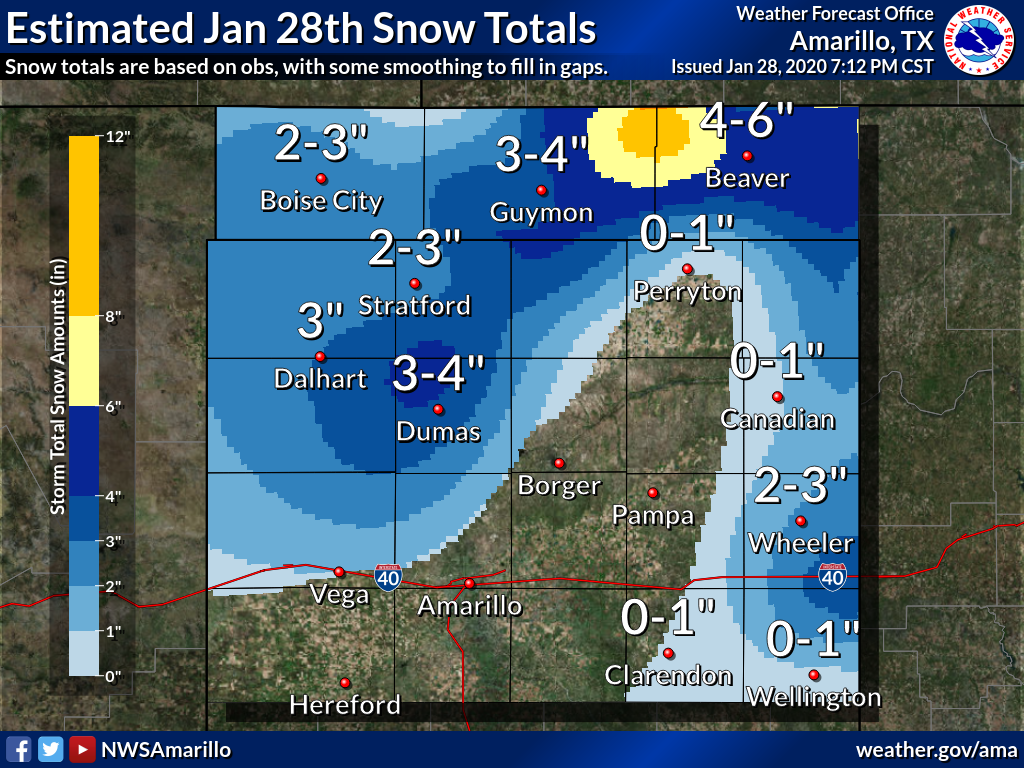
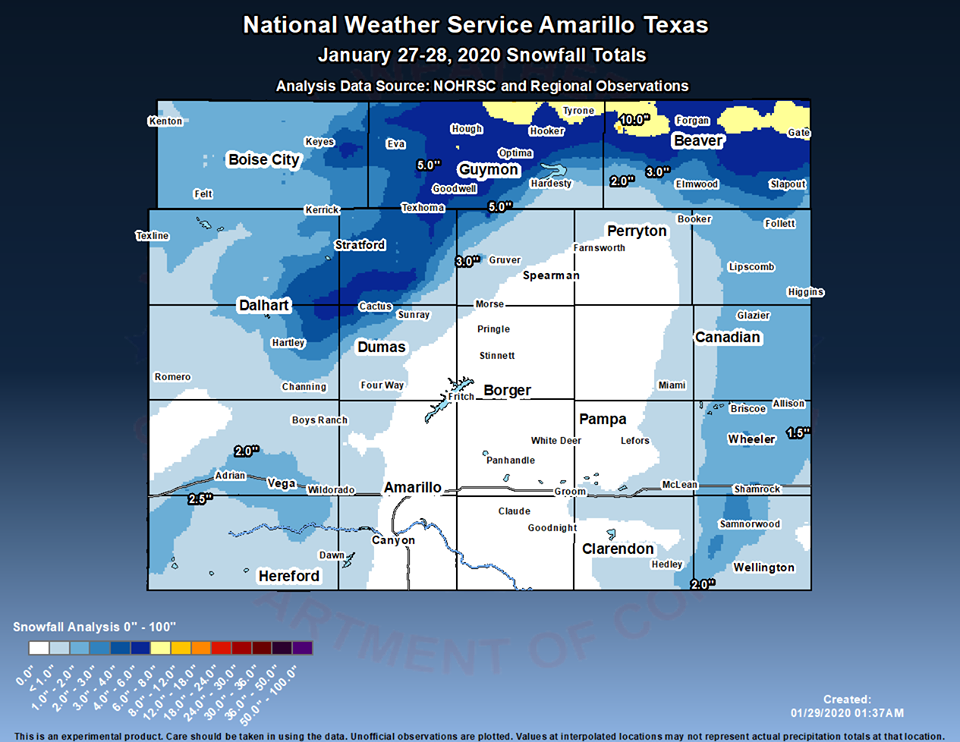
Snow estimate totals are based on observations and smoothing to fill in the vacant gaps. See storm reports for more accurate snow measurements at any given point.
Photos & Video
Header
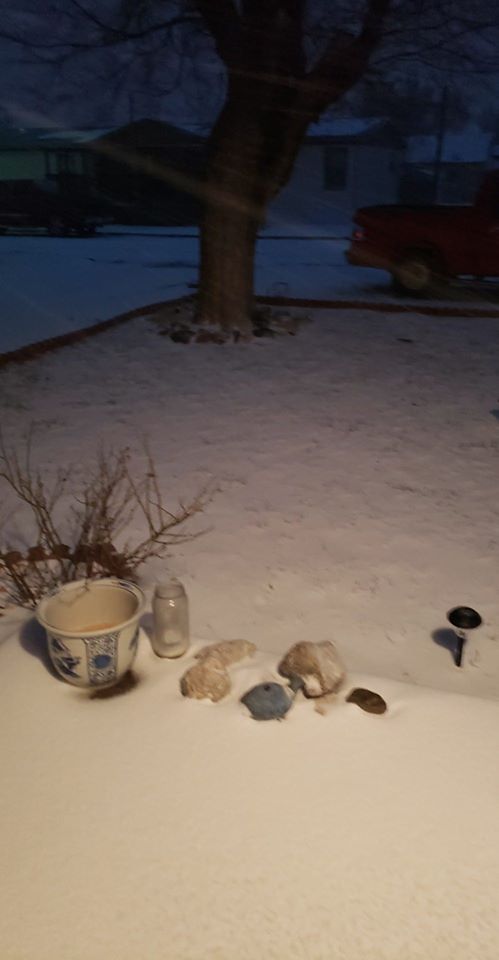 |
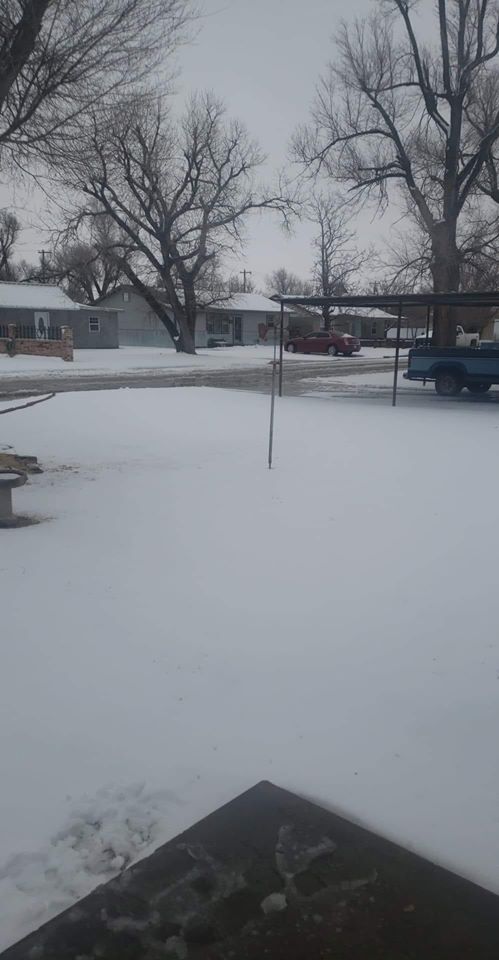 |
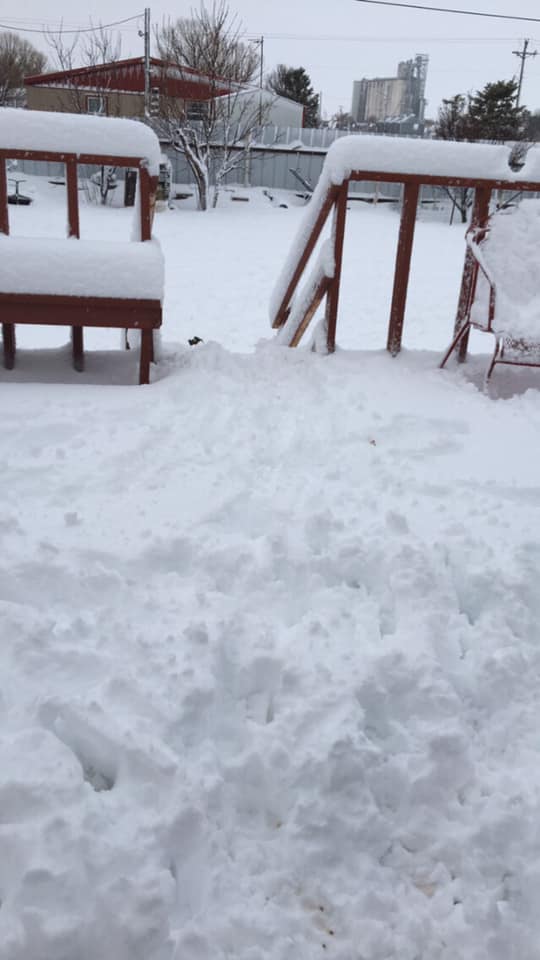 |
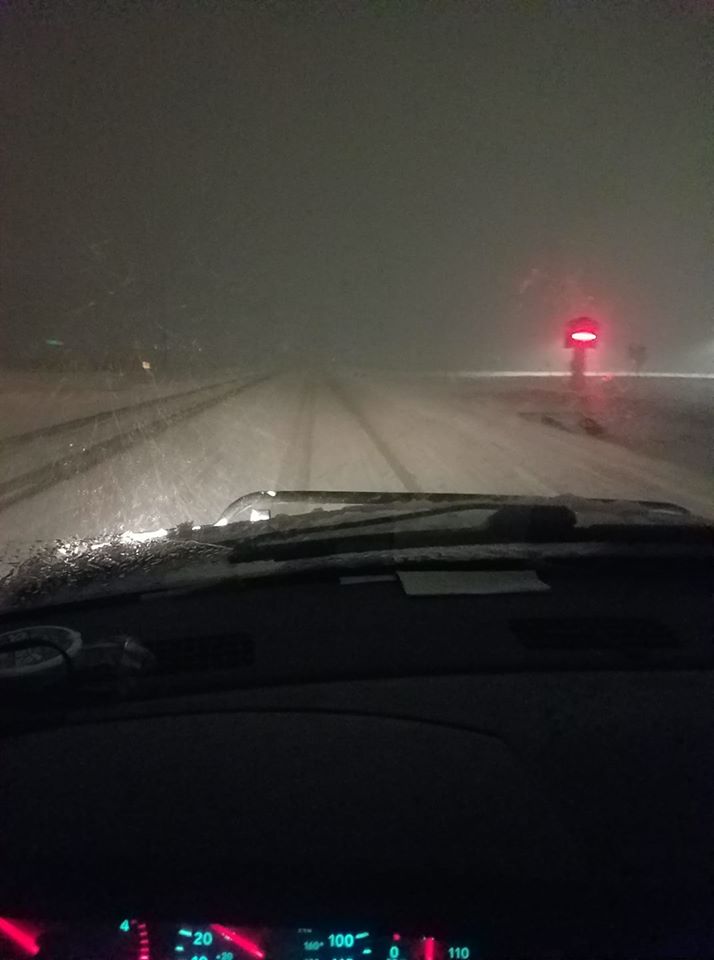 |
| Booker TX 1 Wrobyn Lovins |
Booker TX 2 Wrobyn Lovins |
Dumas TX Rebekah Garnett |
Guymon to Hardesty Garrett Mccargish |
Radar & Satellite
Radar loop from midnight through 4 PM January 28th. The area in red on satellite is the snow on the ground.
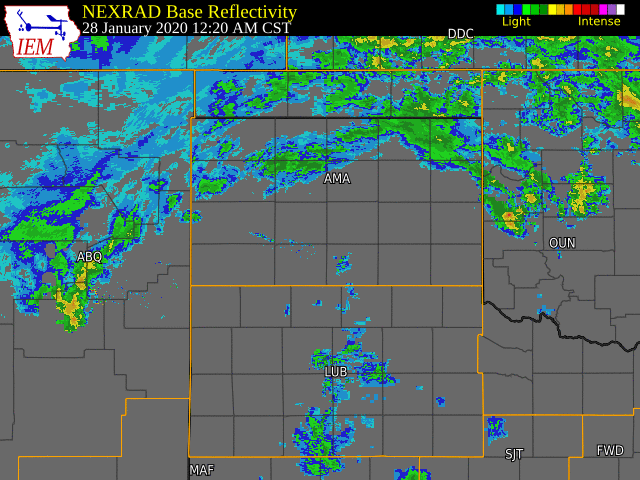 |
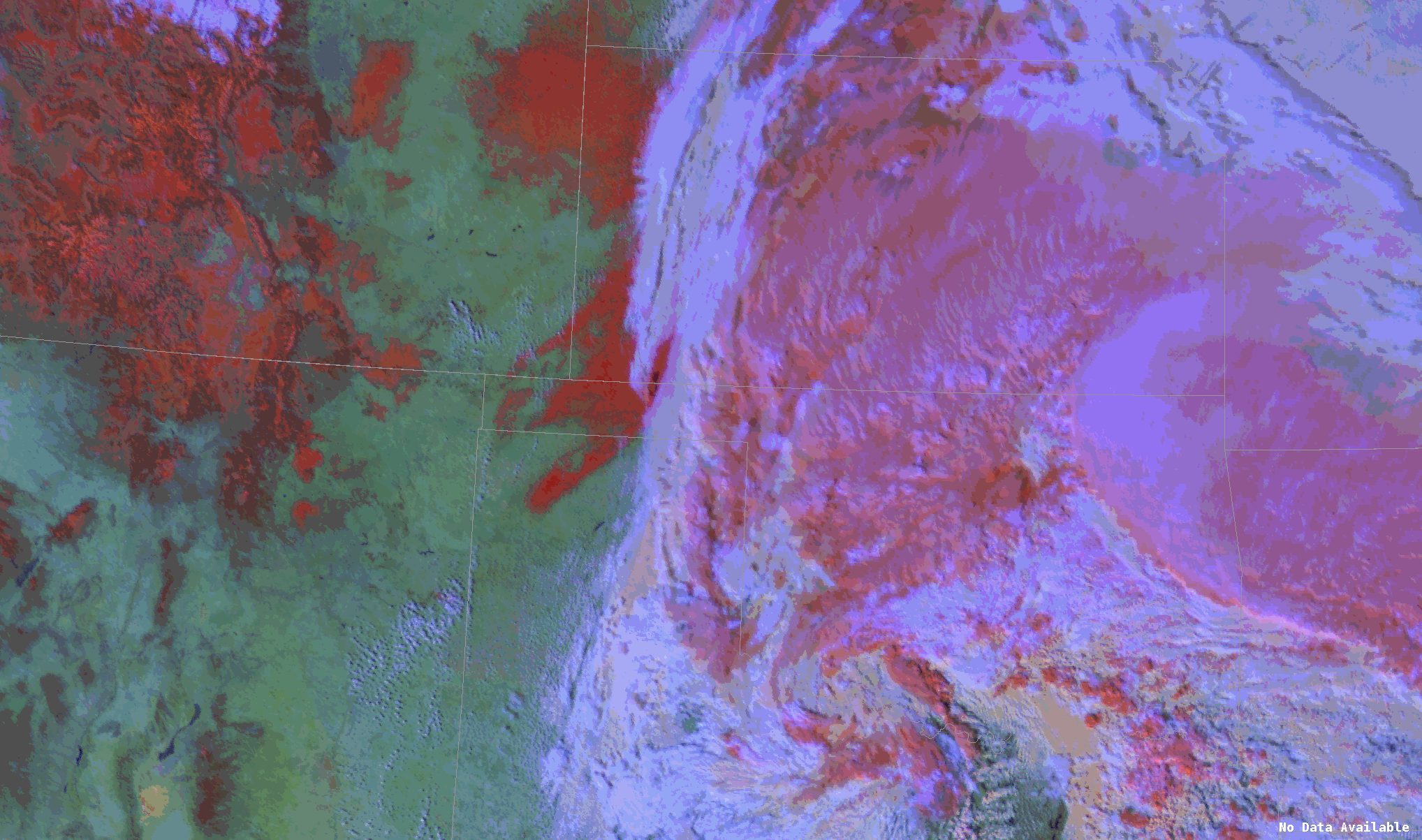 |
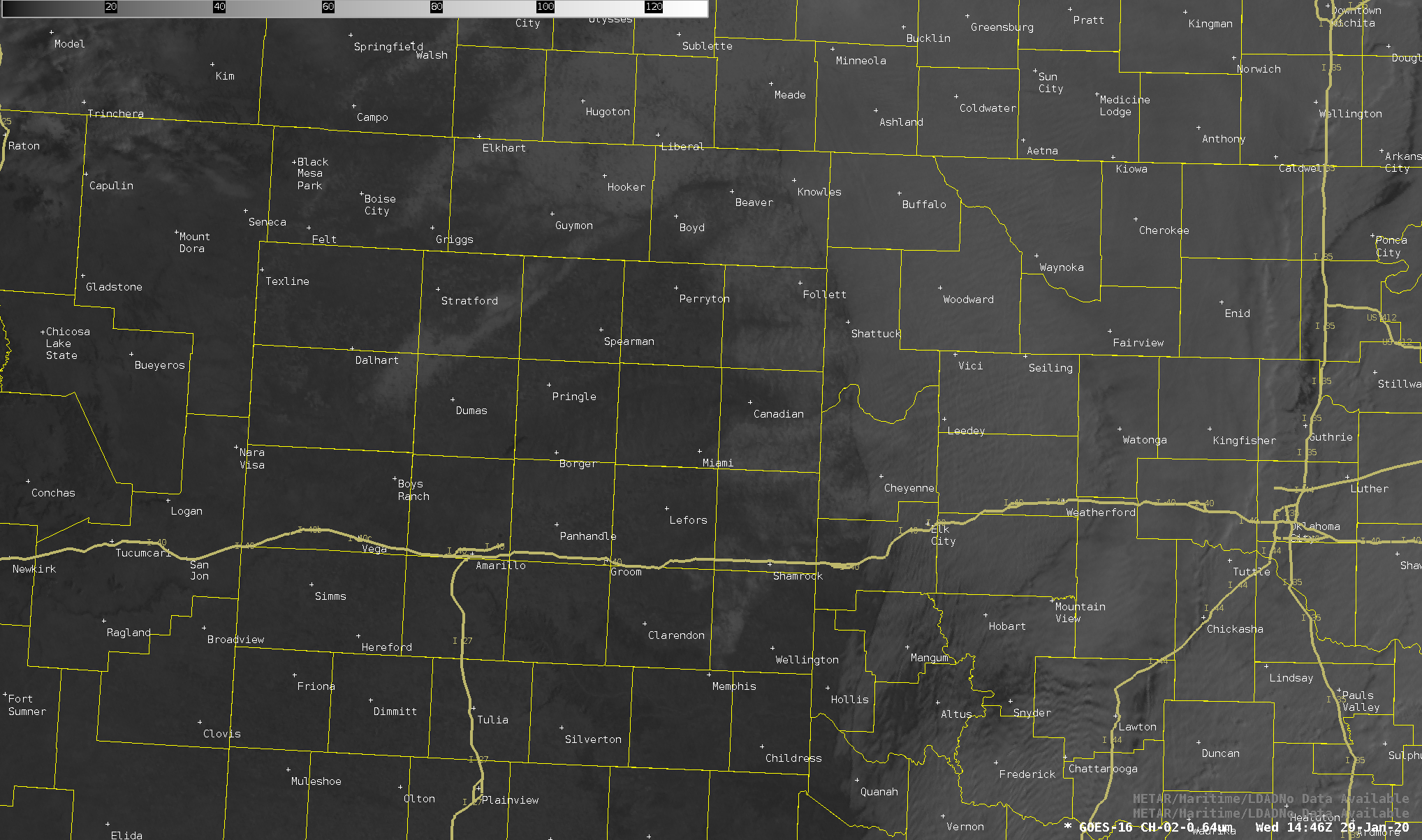 |
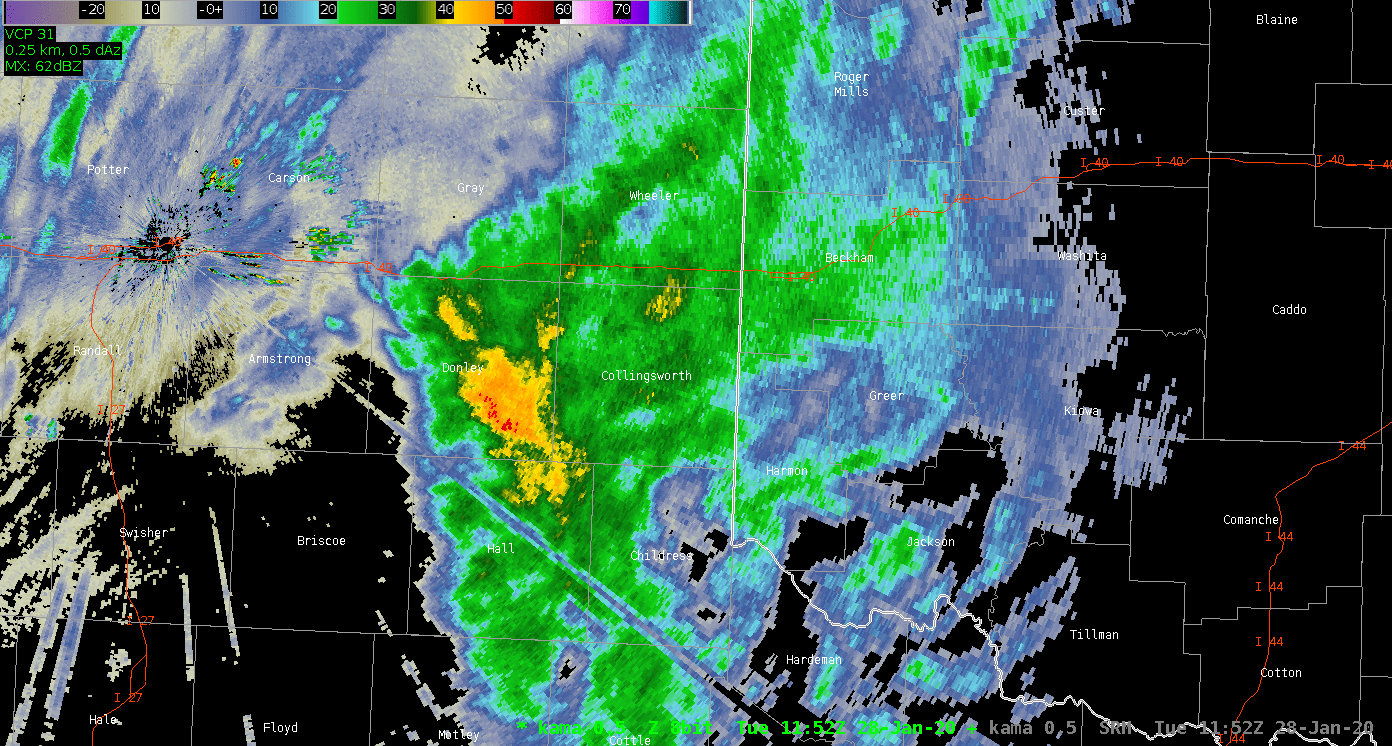 |
| 16 Hour Radar Loop | Satellite Image Snow on Ground | Visible Satellite of Snow on the Ground Morning of Jan 29th | Snow banding in the southeast Texas Panhandle. |
Storm Reports
..TIME... ...EVENT... ...CITY LOCATION... ...LAT.LON... ..DATE... ....MAG.... ..COUNTY LOCATION..ST.. ...SOURCE.... ..REMARKS.. 0417 AM SNOW CHANNING 35.68N 102.33W 01/28/2020 M1.5 INCH HARTLEY TX SOCIAL MEDIA REPORT RECEIVED VIA TWITTER. 0529 AM SNOW FORGAN 36.91N 100.54W 01/28/2020 E3.0 INCH BEAVER OK SOCIAL MEDIA BLOWING SNOW IS ALSO CREATING NEAR ZERO VISIBILITY IN THE AREA. 0535 AM SNOW STRATFORD 36.34N 102.07W 01/28/2020 M2.0 INCH SHERMAN TX LAW ENFORCEMENT BEEN SNOWING SINCE 1:30 AM, SNOW CONTINUES TO FALL WITH ICE PACKED ROADWAYS. 0548 AM SNOW GUYMON 36.69N 101.48W 01/28/2020 E2.0 INCH TEXAS OK LAW ENFORCEMENT LOCAL POLICE REPORTING AT LEAST 2 INCHES OF SNOW ON THE GROUND, WITH SNOW PACKED ROADWAYS. 0557 AM SNOW CHANNING 35.68N 102.33W 01/28/2020 M3.0 INCH HARTLEY TX SOCIAL MEDIA TWITTER REPORT OF SNOW, WHICH IS STILL CONTINUING. 0558 AM SNOW 10 W BOISE CITY 36.73N 102.69W 01/28/2020 M3.0 INCH CIMARRON OK EMERGENCY MNGR SNOW HAS STOPPED FALLING, WITH 3 INCHES MEASURED. 0604 AM SNOW TEXLINE 36.38N 103.02W 01/28/2020 M1.3 INCH DALLAM TX TRAINED SPOTTER 0625 AM SNOW 3 NW DUMAS 35.89N 102.00W 01/28/2020 E4.0 INCH MOORE TX LAW ENFORCEMENT HEAVY SNOW STILL FALLING, MULTIPLE VEHICLES OFF ROADWAY DUE TO SLIPPERY ROADWAYS, BLOWING SNOW REDUCING VISIBILITY. 0630 AM SNOW DALHART 36.06N 102.51W 01/28/2020 M2.0 INCH DALLAM TX TRAINED SPOTTER 0641 AM SNOW FORGAN 36.91N 100.54W 01/28/2020 M6.0 INCH BEAVER OK LAW ENFORCEMENT LAW ENFORCEMENT IS REPORTING HALF A FOOT OF SNOW IN FORGAN, OK WITH DRIFTING. HEAVY SNOW AND LOW VISIBILITY CONTINUES. 0642 AM SNOW TURPIN 36.87N 100.88W 01/28/2020 E7.0 INCH BEAVER OK LAW ENFORCEMENT BEAVER COUNTY SHERIFF`S OFFICE IS REPORTING 7 INCHES OF SNOW WITH DRIFTS UP TO A FOOT IN TURPIN, OK. BLOWING SNOW, HEAVY AT TIMES, WITH REDUCED VISIBILITY CONTINUES. 0703 AM SNOW VEGA 35.25N 102.43W 01/28/2020 M1.5 INCH OLDHAM TX LAW ENFORCEMENT BLOWING SNOW CONTINUES WITH NEAR WHITEOUT CONDITIONS CONTINUING BETWEEN ADRIAN AND VEGA. 0725 AM SNOW MCLEAN 35.23N 100.60W 01/28/2020 E1.0 INCH GRAY TX DEPT OF HIGHWAYS TXDOT CREW REPORTED AT LEAST AN INCH OF SNOW ON THE GROUND AND PLOWING. HEAVY SNOW CONTINUED AT TIME OF REPORT. 0736 AM SNOW HOOKER 36.86N 101.21W 01/28/2020 M7.0 INCH TEXAS OK CO-OP OBSERVER SNOW STILL FALLING. 0737 AM SNOW 6 W GRUVER 36.27N 101.51W 01/28/2020 E3.0 INCH HANSFORD TX DEPT OF HIGHWAYS TXDOT CREW REPORTED 3 INCHES OF SNOW ALONG TEXAS HIGHWAY 15 WEST OF GRUVER. 0737 AM SNOW 9 WSW HITCHLAND 36.47N 101.48W 01/28/2020 E5.0 INCH HANSFORD TX DEPT OF HIGHWAYS TXDOT CREW REPORTED 5 INCHES OF SNOW WITH DRIFTING OVER ROADWAY ALONG TX HIGHWAY 136 NORTH OF GRUVER NEAR THE OKLAHOMA STATE LINE. 0756 AM SNOW GOODWELL 36.59N 101.63W 01/28/2020 M4.5 INCH TEXAS OK PUBLIC 0757 AM SNOW DALHART 36.06N 102.52W 01/28/2020 M3.0 INCH DALLAM TX CO-OP OBSERVER BLOWING SNOW REPORTED 0808 AM SNOW BRYANS CORNER 36.62N 100.82W 01/28/2020 M2.0 INCH BEAVER OK LAW ENFORCEMENT LAW ENFORCEMENT REPORTS 2 INCHES IN BRYAN`S CORNER. 0811 AM SLEET 1 W PERRYTON 36.39N 100.82W 01/28/2020 M0.4 INCH OCHILTREE TX CO-OP OBSERVER 0814 AM SNOW CANADIAN 35.91N 100.38W 01/28/2020 E1.0 INCH HEMPHILL TX LAW ENFORCEMENT LAW ENFORCEMENT REPORTS INCH OF SNOW IN CANADIAN, MODERATE SNOW STILL FALLING. 0822 AM SNOW BOISE 35.21N 102.86W 01/28/2020 M2.5 INCH OLDHAM TX PUBLIC SNOW HAS SINCE ENDED. 0830 AM SNOW 1 ENE CACTUS 36.05N 102.00W 01/28/2020 E5.0 INCH MOORE TX LOCAL OFFICIAL SNOW STOPPED FALLING AT 8:30 AM, WITH 5 INCHES HAVING FALLEN. OFFICIALS AND STORM SPOTTERS REPORTED MULTIPLE SEMIS AND A BUS SLID OFF THE ROAD, SHUTTING DOWN U.S. HIGHWAY 287. 0905 AM SNOW 12 N TEXHOMA 36.66N 101.81W 01/28/2020 M5.0 INCH TEXAS OK TRAINED SPOTTER LIGHT SNOW WAS STILL FALLING. 0915 AM SNOW 2 E LELA 35.22N 100.30W 01/28/2020 M1.5 INCH WHEELER TX SOCIAL MEDIA SNOW WAS STILL FALLING. 0917 AM SNOW BEAVER 36.81N 100.52W 01/28/2020 M3.0 INCH BEAVER OK EMERGENCY MNGR EMERGENCY MANAGER MEASURED 3 INCHES OF SNOW IN BEAVER. 0954 AM HEAVY SNOW TURPIN 36.87N 100.88W 01/28/2020 E10.0 INCH BEAVER OK EMERGENCY MNGR 1111 AM SNOW GATE 36.85N 100.06W 01/28/2020 M5.0 INCH BEAVER OK EMERGENCY MNGR 1112 AM SNOW 1 N BEAVER 36.83N 100.52W 01/28/2020 M5.0 INCH BEAVER OK EMERGENCY MNGR JUST NORTH OF BEAVER. 1225 PM SNOW BRISCOE 35.58N 100.29W 01/28/2020 E2.5 INCH WHEELER TX TRAINED SPOTTER LIGHT SNOW FALLING AT TIME OF REPORT. 1233 PM SNOW 2 N KELTON 35.43N 100.11W 01/28/2020 E1.5 INCH WHEELER TX TRAINED SPOTTER SNOW HAD ENDED SHORTLY BEFORE CALL. 0105 PM SNOW SHAMROCK 35.22N 100.25W 01/28/2020 E4.5 INCH WHEELER TX TRAINED SPOTTER LIGHT SNOW AT TIME OF REPORT. CAR CRASHES REPORTED ALONG HIGHWAY 83 NORTH OF SHAMROCK WITH POOR ROAD CONDITIONS. 0130 PM SNOW SLAPOUT 36.62N 100.12W 01/28/2020 M5.0 INCH BEAVER OK EMERGENCY MNGR STORM TOTAL SNOW 0130 PM SNOW BALKO 36.63N 100.68W 01/28/2020 M3.0 INCH BEAVER OK EMERGENCY MNGR STORM TOTAL SNOW 0130 PM HEAVY SNOW GATE 36.85N 100.06W 01/28/2020 M6.0 INCH BEAVER OK EMERGENCY MNGR STORM TOTAL SNOWFALL. 0130 PM SNOW ELMWOOD 36.62N 100.52W 01/28/2020 M3.0 INCH BEAVER OK EMERGENCY MNGR STORM TOTAL SNOW. 0143 PM SNOW 4 SSE GILES 34.76N 100.57W 01/28/2020 E2.0 INCH DONLEY TX DEPT OF HIGHWAYS AROUND 2 INCHES ALONG HIGHWAY 287 FROM HEDLEY TO MEMPHIS.
 |
Media use of NWS Web News Stories is encouraged! Please acknowledge the NWS as the source of any news information accessed from this site. |
 |